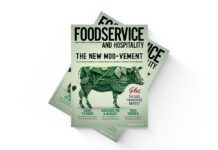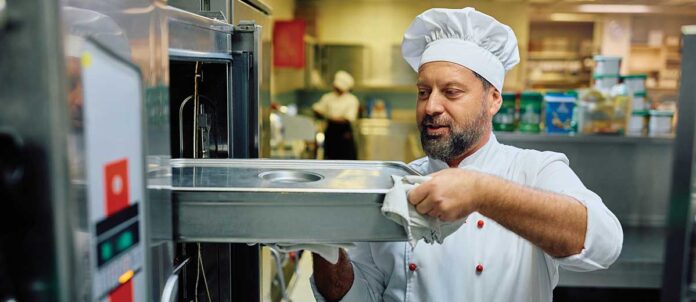By Jenny Febbraro
With today’s technology, the amount of manual labour required in a kitchen is dramatically reduced. As with almost all industries, the future of AI and its implications knocks at the door — with the ever-imposing threat of automatic kitchens void of human labour. But the future has not arrived yet. For the time being, advanced equipment, such as Herculian-strength emulsifiers, mixers, choppers, graters, and processors are reducing labour costs in the kitchen.
An Immersive Experience
“We invented the immersion blender in the 1960s,” says Lance Brown, national Sales manager at the France-based Dynamic Mixers. “The technology really started to evolve in the late 1950s, but it actually became distributed and launched onto the market in 1964, becoming a revolutionary tool.” Made in France, the equipment continues to develop. “We now have over 20 models of this one immersion blender,” he says. “Really it depends on the needs of your kitchen.”
Advanced equipment streamlines the creation of nearly every component of an order. “These are used for everything from soups to sauces to salad dressings — or you might even find it necessary for creating a dessert or icing,” laughs Brown. “But when I first started in this business, the immersion blender was actually thought of as a European tool. Now it can be seen as a staple — even within people’s homes.”
Brown says that the uses of immersion blenders have increased due to guests’ desire for healthy, fresh and local foods. “Pre-packaged or processed foods are not what our increasingly health-conscious guests want anymore,” says Brown. While in the past, restaurants may have relied on pre-fabricated salad dressings, sauces, and dips, now guests expect these basic items to be made onsite from fresh ingredients. “That means that vegetables, spices, whatever you are making has to be blended, chopped, cut, and so on,” says Brown. “And that translates to more labour and higher costs.”
Toronto-based chef Eva Chin uses this tool regularly in her restaurant, The Soy Luck Club. “I use the immersion blender in everything from soups to pancakes,” she says. “It should have at least 500 watts, otherwise it’s just simpler to hand-mix items.” Chin also notes that it’s important to have gradations of speed. “It can become a safety hazard if you have an immersion blender with simply an on-off switch. Get ready for the splash back.”
Slice and Spin
Second to the immersion blender, Brown says that the Dynacube, a manual dicer whereby the blades are encased in a dome, is becoming another required feature of convenience cooking. “A lot of times with manual labour with a simple knife, the end result isn’t always consistent. Say for example in a cooked-meat sandwich, like a chicken salad, you would want that to be the same every time,” explains Brown. “With the Dynacube, you are guaranteed to maintain that precision cut.” In addition, it’s less time-consuming, reducing the cost of labour and safety risk as well.
Dynamic Mixers also brought the salad spinner to the market. “The lettuce dryer or ‘salad spinner’ was something we take credit for inventing,” he says. “It saves kitchen huge costs.” Brown explains that wet lettuce deteriorates within 14 hours in the fridge whereas dry lettuce can last as long as seven days. Its latest product, the Electric Salad Spinner, EM 98 can dry three to five heads of lettuce and preserves the product’s fragility, leaving the lettuce unbruised and ready to dress.
A lot to Process
Kevin Keith, national project manager at the France-based Robot Coupe, says its processors are in more than 75 per cent of restaurants globally — and other businesses such as zoos, pharmacies and cosmetics companies. “We’ve got over 105 different models of food processors,” says Keith. “So, when it comes to serving the restaurant industry, we do a needs assessment first to see what exactly are the needs — and quantities — of the operation.”
“A mom-and-pop style, for example, would purchase a combination food processor. It’s got two different attachments and attaches to a cutter bowl,” he explains. “That one piece of equipment can do anything from julienning French fries to kneading dough to blending soups — the list goes on.” Keith says that the instrument also is popular in Latino restaurants for mixing menu items such as salsa or refried beans.
Keith also says this type of technology also helps to meet kitchen needs due to a big labour shortage. “After COVID, we lost a lot of workers — and it’s been hard to regain that labour force. These tools help to mitigate some of the work behind the scenes.” He recommends the Robot Coupe Table-Top Cutter Mixer R7 for everything from grinding, mincing and kneading, as well as for making mousses, emulsions and smooth stuffings, as it performs typically lengthy tasks in just seconds.
“These are especially handy when you are doing things in bulk – such as for prisons, hotels, or commissaries,” says Keith. “We also have timer features that allow for you to walk away and attend to another task in the kitchen.”
He says that AI isn’t taking over the industry just yet however. “You still need people in the kitchen — and that’s a good thing. But the automation technology just makes cooking faster and more consistent.”


















